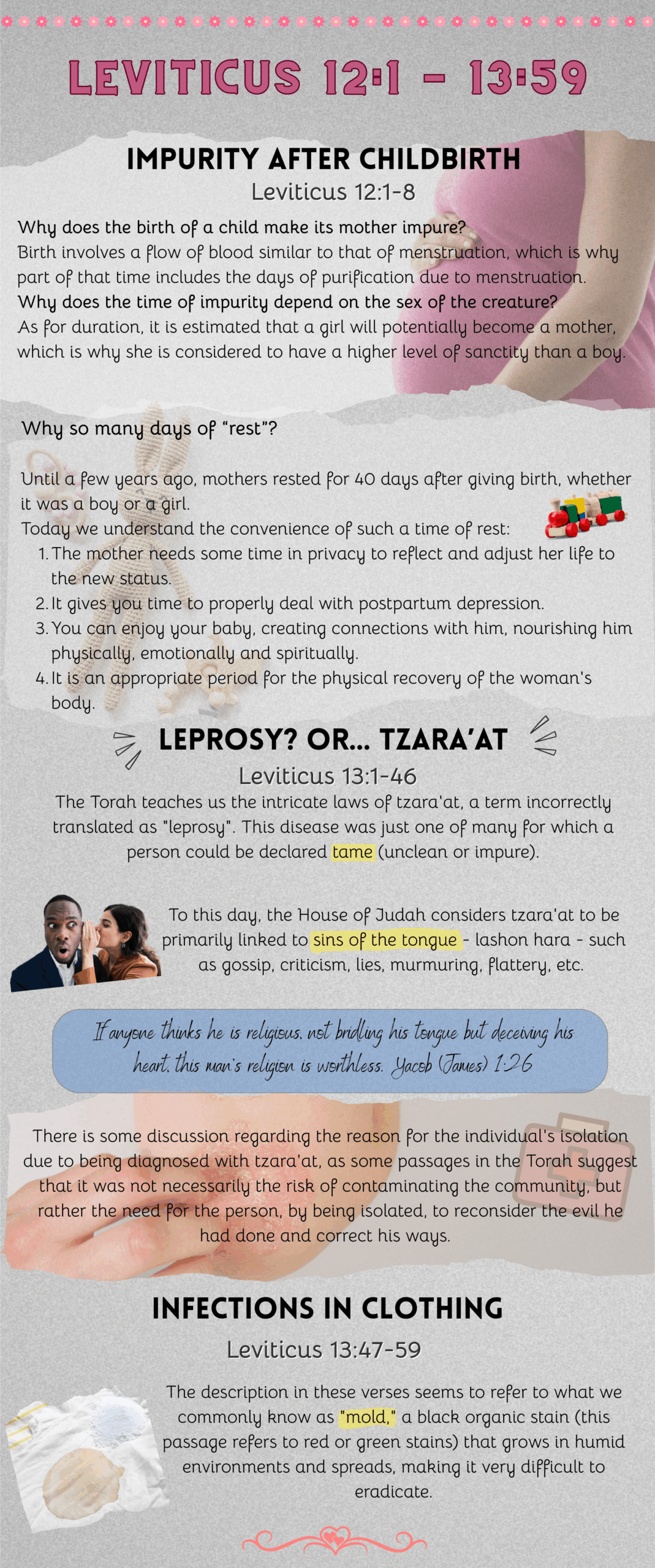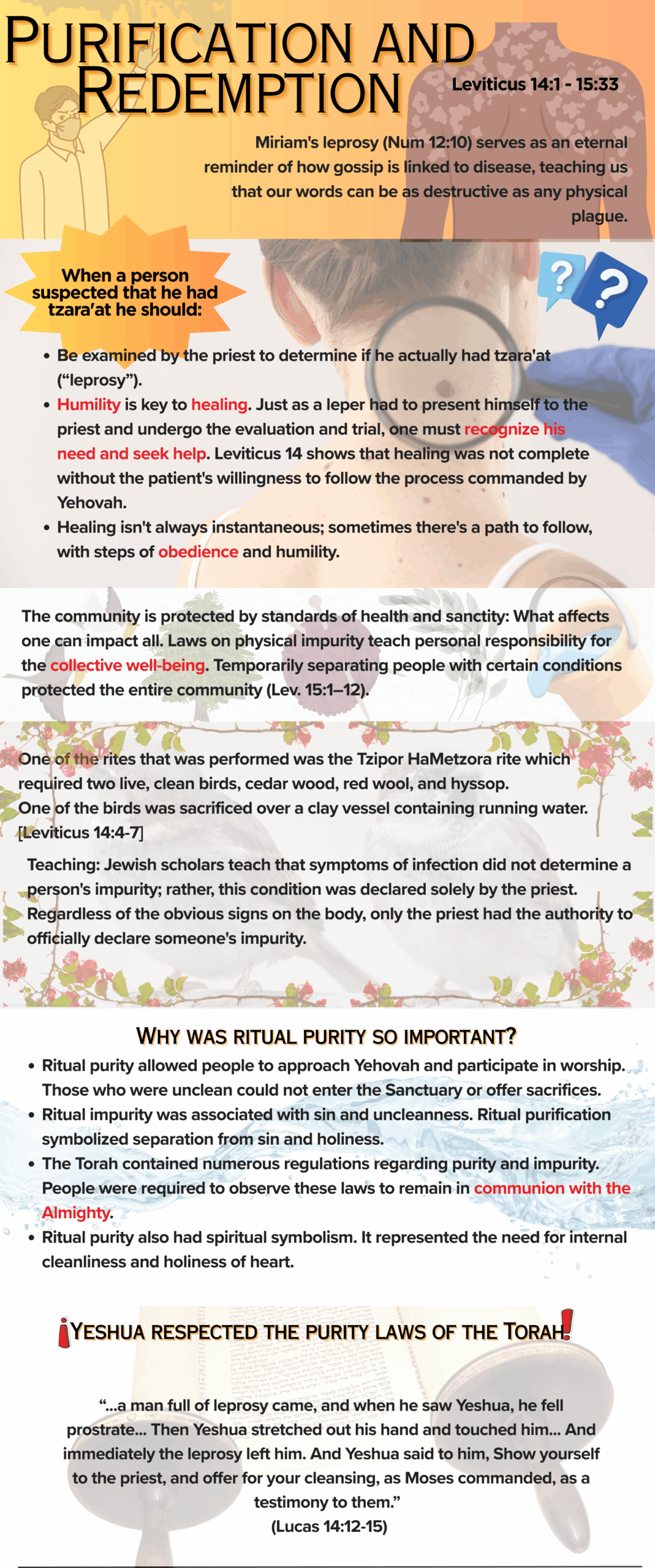Parashah Tazria
Leviticus 12:1 – 13:59
The name of the portion, TAZRIA, is related to the Hebrew root ZARAH, which means “seed”; therefore, an alternative translation of “When a woman conceives” could be “WHEN A WOMAN CARRIES A SEED”.
Yehovah our Father knows very well the work of His Hands, and that is why He gives instructions that, although they may not be entirely understandable, have their reason for being, are appropriate, and must be obeyed. The Creator’s care for His creatures is once again evident in providing these commandments, so that those mothers who decide to heed this ordinance may find a great blessing for themselves and their children.
However, it is curious that in this passage different instructions are given for when a woman gives birth to a boy or a girl. We will try to answer some common questions about this.

The term tzara’at covers various skin disorders, such as eczema, psoriasis, and ringworm (the latter caused by different bacteria on the skin of the scalp, causing ulcers, scabs, itching, etc., and leading to hair loss). The purpose of isolation, in addition to providing the person with time for reflection, was also to allow them to rest and to prevent contamination of those who came into contact with them when the disease was contagious.
Tzara’at is a representation of the sin that dwells within us. Even though we have submitted our lives to Yeshua, we will have to fight a battle for the rest of our lives against the tendencies, appetites, inclinations, customs, and passions of the “flesh,” that is, the sinful nature that dwells within us, which, if we are not careful, will take us by surprise and lead us to break fellowship with our Father Yehovah.
Today we know that many skin diseases have a nervous origin, which is why there is a great need for rest. The priest examined the sick person after seven days, and if he was healthy, he was allowed to rejoin the community. We can assume that the sick person, finding himself detached from all his responsibilities and other tasks, had time for deep reflection that would lead him to make resolutions to correct his mistakes and align himself with the Torah—the instructions of Yehovah.
Parashah Metzora
Leviticus 14:1 15:33
Metzora is the name of the weekly portion of the Torah found in the book of Leviticus (Vayikra), specifically in chapters 14 and 15, and means “he who has leprosy”. This parashah deals mainly with the laws relating to the purification of people and objects affected by tzara’at, a skin disease commonly translated as “leprosy” in the Bible, although its exact meaning is uncertain.
The context of the Metzora portion focuses on the detailed prescriptions for dealing with tzara’at in both people and houses. It describes the purification rituals that must be followed by those who have been affected by this disease, as well as the actions that priests must take to purify the sick and cleanse their belongings.
In addition to the laws concerning tzara’at, the laws of purification related to seminal emission, menstruation, and other types of bodily discharge are also addressed.

Metzora offers us a powerful reflection on the importance of purity, both physical and spiritual, in our lives. Through the narrative of the purification of the leper, we find a call to examine our own impurities and seek restoration of both body and soul. In this sense, the figure of Yeshua emerges as the highest paradigm of purification, offering not only physical healing but also spiritual redemption. His life and teachings remind us of the intrinsic connection between physical cleanliness and purity of heart, inviting us to seek not only the cure for our physical ailments but also the inner renewal that can only come through grace and forgiveness.
As we contemplate Metzora in light of the figure of Yeshua, we are challenged to recognize that the purification of our physical bodies is only the first step on the path to true spiritual transformation. Just as the leper had to be purified in order to be reintegrated into the community, we too must constantly seek the purification of our souls, freeing ourselves from sin and selfishness. In Yeshua we find the perfect example of how physical healing and spiritual redemption go hand in hand, reminding us that our physical health is intrinsically linked to the health of our spirit. May we, like the purified leper, experience the fullness of life that comes from being restored in body and soul by the grace of the One who is the very source of all purity and healing.